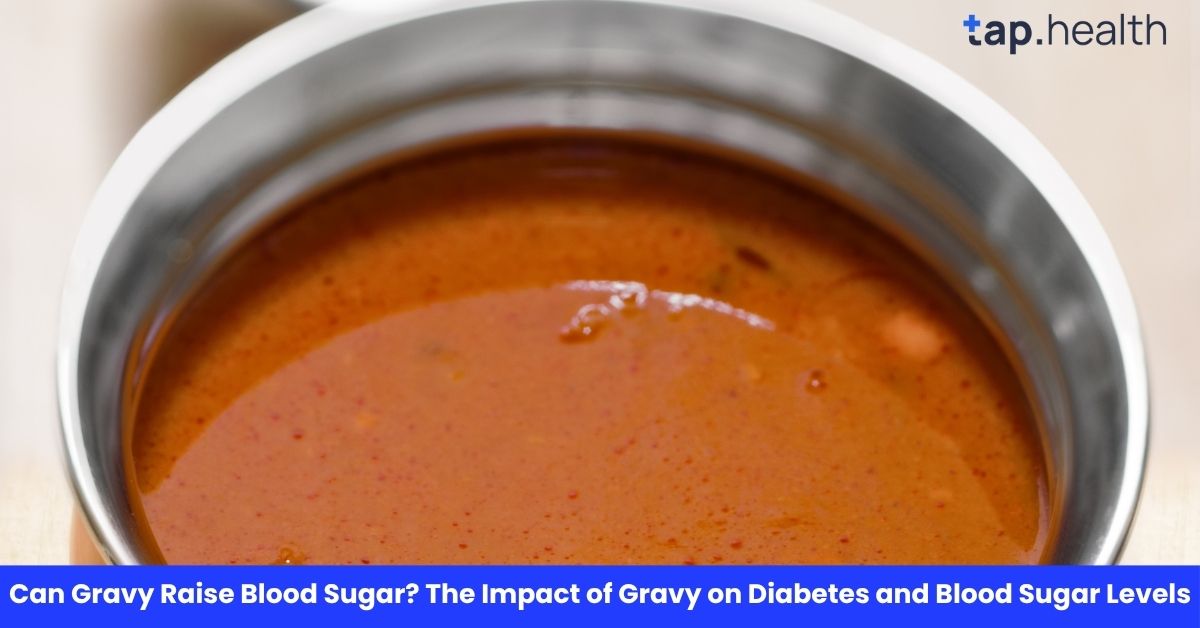WGravy is a popular addition to many dishes, enhancing flavor and texture. Whether served with meats, potatoes, or other sides, gravy adds richness to meals that many people enjoy. But if you’re someone with diabetes or trying to manage blood sugar levels, you might wonder: Can gravy raise blood sugar? This is an important question, especially since blood sugar management is a key aspect of controlling diabetes.
In this blog, we’ll explore how gravy affects blood sugar, what ingredients are at play, and how you can enjoy this delicious dish without compromising your health.
What is Gravy Made Of?
Before diving into how gravy might impact your blood sugar levels, it’s important to understand what goes into making gravy. Gravy is typically made from the drippings of cooked meat, thickened with flour or cornstarch, and seasoned with salt, pepper, and various herbs.
Key Ingredients in Gravy:
- Meat Drippings: The flavorful fats and juices that are left behind after cooking meat, such as chicken, beef, or turkey.
- Flour or Cornstarch: These are used as thickening agents. Flour, especially, can have a high glycemic index (GI), meaning it can cause blood sugar to rise quickly.
- Seasonings: Salt, pepper, garlic, and herbs are common in gravy. These usually don’t have a significant impact on blood sugar, but high salt intake can contribute to hypertension, which is often linked with diabetes.
Can Gravy Raise Blood Sugar?
Now, let’s address the question directly: Can gravy raise blood sugar? The answer is yes, it can, depending on the ingredients used to make it. The two primary factors that influence blood sugar levels are the type of thickener used (flour vs. cornstarch) and the overall glycemic load of the meal.
1. Flour-Based Gravy
Gravy made with flour, especially white flour, can raise blood sugar levels. White flour is a refined carbohydrate that quickly breaks down into glucose (sugar) in the bloodstream. This can cause a spike in blood sugar levels. People with diabetes or those trying to manage their blood sugar may need to be cautious about consuming gravy thickened with flour.
Why Flour Affects Blood Sugar
Flour is made from wheat, which is a grain high in carbohydrates. When consumed, these carbs are broken down into sugar, causing an increase in blood glucose. The glycemic index (GI) of flour is high, meaning it is quickly absorbed into the bloodstream.
2. Cornstarch-Based Gravy
Cornstarch is another common thickener used in gravy. It is a refined carbohydrate like flour, and it can also raise blood sugar levels. However, cornstarch tends to have a slightly lower GI than flour. While it still contributes to blood sugar spikes, it may not cause as rapid an increase as flour-based gravies.
3. High Salt Content
Gravy is often salted to enhance its flavor. While salt doesn’t directly raise blood sugar, it can affect overall health by increasing blood pressure, which is a concern for people with diabetes. High blood pressure and diabetes often go hand in hand, so consuming too much salt in gravy could indirectly influence your ability to manage blood sugar.
How Gravy Affects People with Diabetes
For those living with diabetes, managing blood sugar levels is crucial. Consuming foods that cause rapid blood sugar spikes can lead to poor diabetes control, which increases the risk of complications like heart disease, nerve damage, and kidney disease.
1. Impact of Gravy on Insulin Sensitivity
Gravy, especially when made with flour or cornstarch, can impact insulin sensitivity. When blood sugar rises too quickly, the body may have to produce more insulin to compensate. Over time, this can contribute to insulin resistance, a condition where the body’s cells no longer respond effectively to insulin. This is a key issue for type 2 diabetes.
2. Blood Sugar Spikes After Eating Gravy
A meal that includes gravy can cause a spike in blood sugar, especially if it’s high in refined carbs. If you’re already managing diabetes with medication or insulin, this spike could make it harder to control your glucose levels. Monitoring the type of gravy and the portion size is important.
3. Portion Control is Key
If you love gravy but want to manage your blood sugar levels, portion control is essential. A small amount of gravy will have a less significant impact on blood sugar than a large serving. Pairing gravy with lower-glycemic foods, like non-starchy vegetables or whole grains, can help mitigate its effect on blood sugar.
Gravy Alternatives for Diabetics
If you love gravy but want to avoid the blood sugar spikes, there are several ways to enjoy a healthier version.
1. Use Whole Wheat Flour or Almond Flour
Instead of using refined white flour, try using whole wheat flour or almond flour as a thickening agent. These alternatives have a lower glycemic index and contain more fiber, which helps stabilize blood sugar levels.
2. Opt for Low-Sodium or Homemade Gravy
Store-bought gravies often contain high amounts of salt. High salt intake can contribute to hypertension, which is a concern for diabetics. Making your own gravy at home allows you to control the amount of salt added. You can also use low-sodium broth or reduce the amount of salt to make a heart-healthy version.
3. Use Vegetable or Chicken Broth
Instead of using heavy meat drippings, try using vegetable or chicken broth as a base for your gravy. Broths tend to have fewer fats and calories, making them a healthier option for those watching their blood sugar and overall health.
4. Thicken with Arrowroot Powder or Xanthan Gum
Arrowroot powder and xanthan gum are alternative thickeners that are lower in carbohydrates than flour or cornstarch. These options won’t cause a significant spike in blood sugar, and they can give your gravy the same texture.
The Glycemic Index of Gravy and Other Foods
The glycemic index (GI) is a scale that ranks foods based on how they affect blood sugar levels. Foods with a high GI cause rapid spikes in blood sugar, while those with a low GI cause a slower, more gradual increase.
1. Glycemic Index of Flour and Cornstarch
Flour typically has a high glycemic index (GI of 70 or above), which means it can cause a quick increase in blood sugar. Cornstarch is slightly better, with a GI of around 50, but it’s still a refined carb.
2. Glycemic Index of Alternative Thickeners
Arrowroot powder and xanthan gum have a very low GI, making them better options for people with diabetes. These alternatives won’t raise blood sugar as quickly as flour or cornstarch.
3. Pairing Gravy with Low-Glycemic Foods
To reduce the impact of gravy on blood sugar, it’s important to pair it with low-GI foods. Vegetables, whole grains, and lean proteins can help lower the overall glycemic load of your meal.
Can You Enjoy Gravy with Diabetes?
Yes, you can still enjoy gravy with diabetes, but moderation is key. Here are some tips to make gravy a part of your diabetes-friendly meal plan:
- Watch portion sizes: Keep the amount of gravy small to avoid excessive sugar spikes.
- Use healthier thickeners: Switch to whole wheat flour, almond flour, or low-carb alternatives like xanthan gum.
- Control sodium levels: Opt for low-sodium or homemade gravies to manage your salt intake.
- Balance your meal: Pair gravy with low-GI foods like vegetables, whole grains, and lean proteins.
Real-Life Scenario
Imagine having Thanksgiving dinner with mashed potatoes, turkey, and a generous serving of gravy. While the turkey and vegetables have minimal impact on blood sugar, the gravy—especially if thickened with flour—can cause a noticeable rise in glucose levels. People with diabetes may see their blood sugar increase significantly if they pour extra gravy on their plate.
Expert Contribution
Nutritionists and endocrinologists note that gravy’s effect on blood sugar depends on its ingredients and portion size. Gravies made from pan drippings with minimal flour or thickeners and without added sugar have a lower impact. Experts recommend measuring servings and opting for healthier alternatives like broth-based or vegetable gravies.
Recommendations Grounded in Proven Research and Facts
- Check ingredients: Avoid gravies with added sugar or excessive flour/cornstarch.
- Portion control: Limit the amount of gravy on your plate to reduce its impact on blood sugar.
- Healthier alternatives: Use broth, tomato-based sauces, or pureed vegetables to thicken gravy instead of flour or cornstarch.
- Combine with protein and fiber: Eating gravy with lean protein and fiber-rich vegetables slows down glucose absorption.
- Monitor blood sugar: If you have diabetes, check your glucose after meals to see how gravy affects your levels.
FAQ: Can Gravy Raise Blood Sugar?
1. Can I eat gravy if I have diabetes?
Yes, but you should be cautious. Choose healthier alternatives for the thickening agents and control your portion sizes.
2. What can I use to thicken gravy instead of flour?
Arrowroot powder, xanthan gum, and almond flour are excellent alternatives to flour for thickening gravy.
3. Does gravy contain sugar?
Traditional gravy doesn’t typically contain sugar, but the refined carbs from flour or cornstarch can cause blood sugar spikes.
4. Is low-sodium gravy better for diabetics?
Yes, low-sodium gravy is better for diabetics because it helps manage blood pressure and reduces the risk of hypertension.
5. Can I use gravy as a diabetic treat?
Gravy can be part of a diabetic-friendly meal if used in moderation and with the right ingredients.
Conclusion
Gravy can indeed raise blood sugar levels, particularly if it’s made with high-glycemic ingredients like flour or cornstarch. For diabetics, it’s essential to be mindful of what goes into your gravy and how much you consume. By opting for healthier ingredients and portion control, you can enjoy gravy without worrying about its impact on your blood sugar.
Always consult with a healthcare provider or dietitian if you’re unsure about how certain foods affect your diabetes management. With the right approach, you can continue to enjoy your favorite meals without compromising your health.



